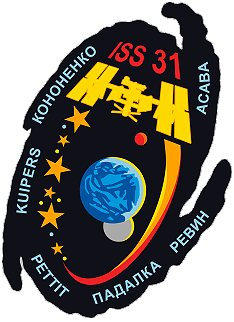Resident Crews of the International Space Station (ISS)
![]()
ISS: Expedition 31 |
 |
![]()
Crew, launch- and landing data
| No. | Nation | Surname | Given names | Position | Spacecraft (launch) |
Launch date |
Launch time |
Spacecraft (landing) |
Landing date |
Landing time |
Mission duration |
Orbits |
| 1 | Kononenko | Oleg Dmitriyevich | ISS-CDR | Soyuz TMA-03M | 21.12.2011 | 13:16:14.190 UTC | Soyuz TMA-03M | 01.07.2012 | 08:14:41.2 UTC | 192d 18h 58m 28s | 3007 | |
| 2 | Padalka | Gennadi Ivanovich | Flight Engineer-1 | Soyuz TMA-04M | 15.05.2012 | 03:01:22.968 UTC | Soyuz TMA-04M | 17.09.2012 | 02:52:51.9 UTC | 124d 23h 51m 30s | 1946 | |
| 3 | Revin | Sergei Nikolayevich | Flight Engineer-2 | Soyuz TMA-04M | 15.05.2012 | 03:01:22.968 UTC | Soyuz TMA-04M | 17.09.2012 | 02:52:51.9 UTC | 124d 23h 51m 30s | 1946 | |
| 4 | Acaba | Joseph Michael | Flight Engineer-3 | Soyuz TMA-04M | 15.05.2012 | 03:01:22.968 UTC | Soyuz TMA-04M | 17.09.2012 | 02:52:51.9 UTC | 124d 23h 51m 30s | 1946 | |
| 5 | Kuipers | André | Flight Engineer-5 | Soyuz TMA-03M | 21.12.2011 | 13:16:14.190 UTC | Soyuz TMA-03M | 01.07.2012 | 08:14:41.2 UTC | 192d 18h 58m 28s | 3007 | |
| 6 | Pettit | Donald Roy | Flight Engineer-6 | Soyuz TMA-03M | 21.12.2011 | 13:16:14.190 UTC | Soyuz TMA-03M | 01.07.2012 | 08:14:41.2 UTC | 192d 18h 58m 28s | 3007 |
unofficial Backup Crew
| No. | Nation | Surname | Given names | Position |
| 1 | Malenchenko | Yuri Ivanovich | ISS-CDR | |
| 2 | Novitsky | Oleg Viktorovich | Flight Engineer | |
| 3 | Tarelkin | Yevgeni Igorevich | Flight Engineer | |
| 4 | Ford | Kevin Anthony | Flight Engineer | |
| 5 | Williams | Sunita Lyn "Suni" | Flight Engineer | |
| 6 | Hoshide | Akihiko | Flight Engineer |
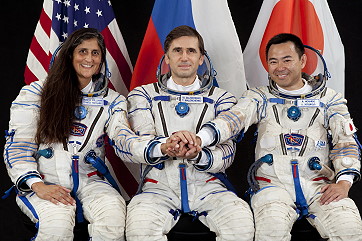 |
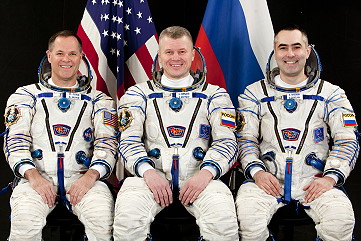 |
 |
Expedition Report
|
Launch from the Baikonur Cosmodrome (Gennadi
Padalka, Sergei
Revin and Joseph
Acaba with
Soyuz
TMA-04M). Oleg
Kononenko, Donald
Pettit and André
Kuipers were onboard since December 23, 2011 (arrival with
Soyuz
TMA-03M). ISS Expedition 31 began with the undocking of spacecraft Soyuz TMA-22 on April 27, 2012 at 08:18:19 UTC. The former Expedition 30 (Anton Shkaplerov, Anatoli Ivanishin and Daniel Burbank) returned safely to Earth. With the arrival of Soyuz TMA-04M on May 17, 2012 the Expedition 31 became a six-person-crew. Soyuz TMA-04M carried Gennadi Padalka, Sergei Revin and Joseph Acaba to the space station. On May 22, 2012 occurred the launch of the Commercial Orbital Transportation Services (COTS). The launch of the Falcon 9 rocket carried an unmanned Dragon capsule. During the flight, SpaceX's Dragon capsule conducted a series of check-out procedures to test and proved its systems, including the capability to rendezvous and berth with the International Space Station. The primary objectives for the flight included a flyby of the space station at a distance of approximately 1.5 miles to validate the operation of sensors and flight systems necessary for a safe rendezvous and approach. Following the rendezvous on May 25, 2012 Dragon was captured and berthed to the station's Harmony node. The pressurized section carried 525 kg (1,157 lb) of cargo to the ISS, which included food, water, clothing, cargo bags, computer hardware, the NanoRacks Module 9 (student experiments and scientific gear) and other miscellaneous cargo. No unpressurized cargo was delivered on this mission. An unannounced addition to the cargo manifest, made public after the launch, was a small canister, affixed to the second stage's top, containing the 1-gram ash remains of over 300 people including Project Mercury Astronaut Gordon Cooper, and James Doohan, the actor who played Scotty on the television show Star Trek in the 1960s. The remains were flown semi-secretly by Celestis, a company that has flown burial canisters in the past on SpaceX's Falcon 1 launch vehicle. Dragon stayed for almost six days during which the astronauts unloaded cargo, and then reloaded Dragon with Earth-bound cargo. On May 31, 2012, Dragon unberthed from the ISS, its capsule landed in the Pacific Ocean off the California coast and was recovered. All the objectives of the mission were successfully completed, and the Falcon 9-Dragon system became certified to start regular cargo delivery missions to the ISS under the Commercial Resupply Services program. On its return to Earth, Dragon brought back 665 kg (1,466 lb) worth of pressurized cargo back to Earth, the cargo included experiment samples, experiment hardware, ISS' systems hardware and Extravehicular Mobility Unit hardware. One of the experiments returned by Dragon was the Shear History Extensional Rheology Experiment (SHERE) administered by NASA's Glenn Research Center. SHERE investigated rotational stress effects on polymer fluids. Items from SHERE included a toolbox, fluid modules, stowage trays, cables and a keyboard, and science data recordings. Another experiment returning with Dragon was the Multi-user Droplet Combustion Apparatus (MDCA), and the Combustion Integrated Rack-Fluids and Combustion Facility (CIR). Another experiment returning at the end of this mission was the Material Science Research Rack (MSRR), which investigated microgravity experiments on aluminum-alloy rods. Returning from MSRR were cartridges from thermal and vacuum investigations done on metal rods in the SETA-2 and the MSL-CETSOL and MICAST studies. Expedition 30 / 31 continued to expand the scope of research aboard the International Space Station now that assembly of the orbiting laboratory is complete. As with prior expeditions, many investigations are designed to gather information about the effects of long-duration spaceflight on the human body, which will help us understand complicated processes such as immune systems with plans for future exploration missions. The investigations cover human research; biological and physical sciences; technology development; Earth observation; and education. The Japan Aerospace Exploration Agency's Monitor of All-sky X-ray Image (MAXI) investigation will be finishing up its stay on the station. MAXI has been installed on the Exposed Facility (JEM EF) of the Japanese Kibo laboratory since Expedition 19/20, monitoring more than 1,000 X-ray sources in space once every 96 minutes using slit cameras, and has already produced significant results in the area of space science. In 2010, MAXI, along with the SWIFT spacecraft, found two new X-ray sources from its sky scans. Both instruments made the first observation of a relativistic (moving at a velocity approaching the speed of light) X-ray burst from a supermassive black hole destroying a star and creating a jet of X-rays. The Commercial Generic Bioprocessing Apparatus Science Insert - 05 (CSI-05) Directional Plant Growth (also referred to as Plants in Space) investigation is continuing, comparing plant growth on the ground (by thousands of students in classrooms around the world) to plant growth in microgravity on board the station. Results from this investigation will continue to expand the knowledge base regarding how plants react in a microgravity environment, using this information to support long-duration deep space missions providing food and oxygen generation. This also allows students to work essentially side-byside with scientists and astronauts. Space radiation exposure is always a concern, and must be protected against. The European Space Agency's Dose Distribution Inside the International Space Station - 3D (DOSIS-3D) investigation will employ various active and passive radiation detector devices to assemble a three-dimensional dose distribution map, of all segments of the station, to determine the radiation field parameters dose and dose equivalent to assist in assessing radiation safe exposure limits and exposure health risks. This investigation will provide important information regarding devices used for data collection and real-time data monitoring, proving valuable to commercial crews and military flight crews regarding radiation monitoring. As part of U.S. National Laboratory activities on the station, Nanoracks modules provide autonomous, self-contained experiments that can be flown quickly and inexpensively by students, companies and other U.S. government agencies. Nanorack investigations during this timeframe will look at exploring the use of readily available commercial-off-the-shelf products and technologies (a smart phone and an electronic book) in microgravity, remote control mechanisms and mechanical devices, the behavior of 18S Ribosomal Ribonucleic Acid (RNA), and the MC3T3 mouse bone cell line, along with several student-based investigations. Earth science is also on the list of topics that generates much interest, and there are many investigations involving this aspect. AuroraMax (simultaneous photography of the aurora borealis from the space station and ground-based observatories), Crew Earth Observations (CEO) (photography of natural and man-made surface changes), HREP-HICO (coastal imagery), and Geoflow-2 (studying heat and flow currents in the Earth's mantle to better understand and predict volcanic eruptions, plate tectonics and earthquakes) are all recording images, many never seen before. The Burning and Suppression of Solids (BASS) investigation examines burning and extinction characteristics of a wide variety of fuel samples in microgravity. Results from this investigation will assist in devising strategies for extinguishing accidental fires in microgravity, along with contributing to advances in fire detection and suppression in microgravity and on Earth. Crew members will observe the burning process, noting flame shape (as a function of flow speed), flame spread rate, and flame dynamics, along with extinction data to be used for comparison to modeling data. A nitrogen suppressant system is used as the means for flame extinction. Checkout and testing of hand motions for Robonaut 2, installed in the U.S. Destiny Laboratory, was planned for later this year. Finally, the station command changed from Russian cosmonaut Oleg Kononenko to Russian cosmonaut Gennadi Padalka. With undocking of Soyuz TMA-03M, carrying Oleg Kononenko, Donald Pettit and André Kuipers on July 01, 2012 at 04:47:43 UTC the Expedition 31 concluded and the new ISS Expedition 32 began. During the stay on board of the ISS the crews of Expeditions 31 / 32 carried out the following scientific experiments: 3DA1 Camcorder (Panasonic 3D Camera) ACE-1 (Advanced Colloids Experiment-1) ALTEA-Dosi (Anomalous Long Term Effects in Astronauts' - Dosimetry) ALTEA-Shield (Anomalous Long Term Effects in Astronauts' Central Nervous System - Shield) AMS-02 (Alpha Magnetic Spectrometer - 02) Alloy Semiconductor (Crystal Growth of Alloy Semiconductor Under Microgravity) Amine Swingbed (Amine Swingbed) Area PADLES (Passive Dosimeter for Lifescience Experiment in Space) BASS (Burning and Suppression of Solids) BCAT-3-4-CP (Binary Colloidal Alloy Test - 3 and 4: Critical Point) BCAT-4-Poly (Binodal Colloidal Aggregation Test - 4: Polydispersion) BCAT-5-3D-Melt (Binary Colloidal Alloy Test - 5: Three-Dimensional Melt) BCAT-5-PhaseSep (Binary Colloidal Alloy Test-5: Phase Separation) BCAT-5-Seeded_Growth (Binary Colloidal Alloy Test - 5: Seeded Growth) BCAT-6-Colloidal_Disks (Binary Colloidal Alloy Test - 6 - Colloidal Disks) BCAT-6-PS-DNA (Binary Colloidal Alloy Test - 6: Polystyrene - Deoxyribonucleic Acid) BCAT-6-Phase_Separation (Binary Colloidal Alloy Test - 6 - Phase Separation) BCAT-6-Seeded_Growth (Binary Colloidal Alloy Test - 6: Seeded Growth) BCAT-C1 (Binary Colloidal Alloy Test - C1) Biological Rhythms 48hrs (The effect of long-term microgravity exposure on cardiac autonomic function by analyzing 48-hours electrocardiogram) Bisphosphonates (Bisphosphonates as a Countermeasure to Space Flight Induced Bone Loss) CEO (Crew Earth Observations) CETSOL-2 (Columnar-to-Equiaxed Transition in Solidification Processing-2) CFE-2 (Capillary Flow Experiment - 2) Card (Long Term Microgravity: A Model for Investigating Mechanisms of Heart Disease with New Portable Equipment) Circadian Rhythms (Circadian Rhythms) DECLIC-ALI (DEvice for the study of Critical LIquids and Crystallization - Alice Like Insert) DOD SPHERES-CSAC (Department of Defense Synchronized Position, Hold, Engage, Reorient, Experimental Satellites-Chip Scale Atomic Clock) DOSIS-3D (Dose Distribution Inside the International Space Station - 3D) DTN (Disruption Tolerant Networking for Space Operations) Dynamic Surf (Experimental Assessment of Dynamic Surface Deformation Effects in Transition to Oscillatory Thermo capillary Flow in Liquid Bridge of High Prandtl Number Fluid) EKE (Assessment of Endurance Capacity by Gas Exchange and Heart Rate Kinetics During Physical Training) ELITE-S2 (ELaboratore Immagini TElevisive - Space 2) EPO-Demos (Education Payload Operation - Demonstrations) ESA-EPO (European Space Agency - Education Payload Operations) ESA NightPod (ESA NightPod) EarthKAM (Earth Knowledge Acquired by Middle School Students) Energy (Astronaut's Energy Requirements for Long-Term Space Flight) FLEX (Flame Extinguishment Experiment) FLEX-2 (Flame Extinguishment Experiment - 2) Functional Task Test (Physiological Factors Contributing to Changes in Postflight Functional Performance) HET-Smartphone (Human Exploration Telerobotics Smartphone) HREP-HICO (HICO and RAIDS Experiment Payload - Hyperspectral Imager for the Coastal Ocean) HREP-RAIDS (HICO and RAIDS Experiment Payload - Remote Atmospheric and Ionospheric Detection System (RAIDS)) Hair (Biomedical Analyses of Human Hair Exposed to a Long-term Space Flight) HiMassSEE (Spacecraft Single Event Environments at High Shielding Mass) Hicari (Growth of Homogeneous SiGe Crystals in Microgravity by the TLZ Method) I-BALL (I-BALL) I-STAR Comm Delay Preparation (ISS Testbed for Analog Research Communication Delay Preparation (I-STAR Comm Delay Preparation)) ISERV (ISS SERVIR Environmental Research and Visualization System) ISSAC (International Space Station Agricultural Camera) ISS Ham Radio (International Space Station Ham Radio) ISS High Efficiency Particle Filter Analysis (International Space Station High Efficiency Particle Filter Analysis) Immuno (Neuroendocrine and Immune Responses in Humans During and After Long Term Stay at ISS) InSPACE-3 (Investigating the Structure of Paramagnetic Aggregates from Colloidal Emulsions - 3) Integrated Cardiovascular (Cardiac Atrophy and Diastolic Dysfunction During and After Long Duration Spaceflight: Functional Consequences for Orthostatic Intolerance, Exercise Capability and Risk for Cardiac Arrhythmias) Integrated Immune (Validation of Procedures for Monitoring Crewmember Immune Function) JAXA-Commercial (Japan Aerospace Exploration Agency - Commercial Payload Program) JAXA EPO 5 (Japan Aerospace Exploration Agency Education Payload Observation 5) JAXA EPO 9 (Japan Aerospace Exploration Agency Education Payload Observation 9) Journals (Behavioral Issues Associated with isolation and Confinement: Review and Analysis of Astronaut Journals) LEGO Bricks (LEGO Bricks, formerly known as NLO-Education-2) MAXI (Monitor of All-sky X-ray Image) MCE (Multi-mission Consolidated Equipment) MFMG (Miscible Fluids in Microgravity) MICAST-2 (The Microstructure Formation in Casting of Technical Alloys under Diffusive and Magnetically Controlled Convective Conditions-2) MISSE-8 (Materials International Space Station Experiment - 8) Marangoni-Exp (Chaos, Turbulence and its Transition Process in Marangoni Convection-Exp) Marangoni-UVP (Spatio-temporal Flow Structure in Marangoni Convection) Medaka Osteoclast (Medaka Osteoclast) Micro-6 (Genotypic and Phenotypic Responses of Candida albicans to Spaceflight) Microbe-III (Microbe-III) NanoRacks-FPTU CubeSat-1 (NanoRacks-FPT University CubeSat-1) NanoRacks-NCESSE-Mission-1 (NanoRacks-National Center for Earth and Space Science Education-Mission-1) Nano Step (In-situ Observation of Growth Mechanisms of Protein Crystals and Their Perfection Under Microgravity) Neurospat (Effect of Gravitational Context on EEG Dynamics: A Study of Spatial Cognition, Novelty Processing and Sensorimotor Integration) Nutrition (Nutritional Status Assessment) ODK2 (Evaluation of Onboard Diagnostic Kit 2) Onboard Diagnostic Kit (Evaluation of Onboard Diagnostic Kit) Photosynth (Photosynth™ Three-Dimensional Modeling of ISS Interior and Exterior) Pro K (Dietary Intake Can Predict and Protect Against Changes in Bone Metabolism during Spaceflight and Recovery) REBR (ReEntry Breakup Recorder) RRM (Robotic Refueling Mission) Radiation Environment Monitor (Radiation Environment Monitor) Reaction Self Test (Psychomotor Vigilance Self Test on the International Space Station) Repository (National Aeronautics and Space Administration Biological Specimen Repository) Resist Tubule (Mechanisms of Gravity Resistance in Plants From Signal Transformation and Transduction to Response) Reversible Figures (Perspective Reversible Figures in Microgravity) Robonaut (Robonaut) SATS-Interact (Supervision of Autonomous and Teleoperated Satellites - Interact) SCAN Testbed (Space Communications and Navigation Testbed) SEDA-AP (Space Environment Data Acquisition Equipment - Attached Payload) SETA-2 (Solidification along a Eutectic path in Ternary Alloys-2) SHERE-II (Shear History Extensional Rheology Experiment - II) SMILES (Superconducting Submillimeter-Wave Limb-Emission Sounder) SNFM (Serial Network Flow Monitor) SODI-DSC (Selectable Optical Diagnostics Instrument - Diffusion and Soret Coefficient) SOLO (SOdium LOading in Microgravity) SPHERES (Synchronized Position Hold, Engage, Reorient, Experimental Satellites) SPHERES-Zero-Robotics (Synchronized Position Hold, Engage, Reorient, Experimental Satellites-Zero-Robotics) STP-H3-Canary (Space Test Program - Houston 3 - Canary) STP-H3-DISC (Space Test Program - Houston 3 - Digital Imaging Star Camera) STP-H3-MHTEX (Space Test Program - Houston 3 - Massive Heat Transfer Experiment) STP-H3-VADER (Space Test Program - Houston 3 - Variable emissivity radiator Aerogel insulation blanket Dual zone thermal control Experiment suite for Responsive space) Small Sat Deploy-Demo (Small Sat Deploy Demo) Solar-SOLACES (Sun Monitoring on the External Payload Facility of Columbus - SOLar Auto-Calibrating EUV/UV Spectrophotometers) Solar-SOLSPEC (Sun Monitoring on the External Payload Facility of Columbus -Sun Monitoring on the External Payload Facility of Columbus -SOLar SPECtral Irradiance Measurements) SpaceDRUMS (Space Dynamically Responding Ultrasonic Matrix System) Space Headaches (Space Headaches) Spin (Validation of Centrifugation as a Countermeasure for Otolith Deconditioning During Spaceflight) Sprint (Integrated Resistance and Aerobic Training Study) TecEdSat (TecEdSat) Thermolab (Thermoregulation in Humans During Long-Term Spaceflight) Tomatosphere-III (Tomatosphere-III) Treadmill Kinematics (Biomechanical Analysis of Treadmill Exercise on the International Space Station) UBNT (Ultrasonic Background Noise Test) V-C REFLEX (Plastic alteration of vestibulo-cardiovascular reflex and its countermeasure) VIABLE ISS (eValuatIon And monitoring of microBiofiLms insidE International Space Station) VO2max (Evaluation of Maximal Oxygen Uptake and Submaximal Estimates of VO2max Before, During, and After Long Duration International Space Station Missions) Vascular (Cardiovascular Health Consequences of Long-Duration Space Flight) Vessel ID System (Vessel ID System) Vessel Imaging (Vascular Echography) You Tube Space Lab (You Tube Space Lab) |
ISS Assembly
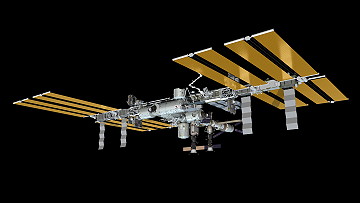 |
 |
 |
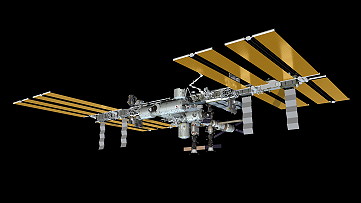 |
Photos
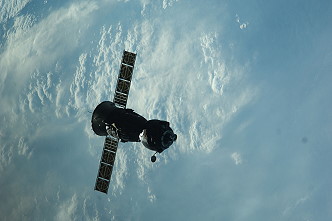 |
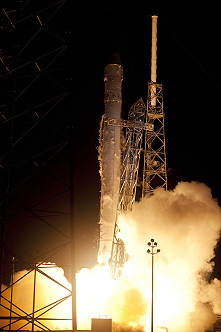 |
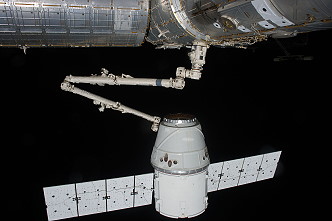 |
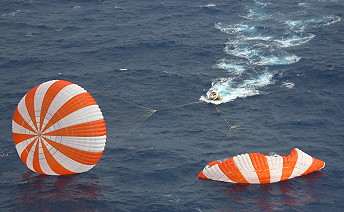 |
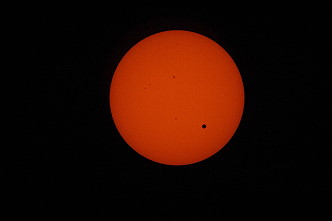 |
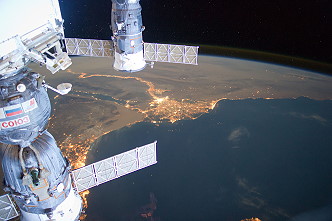 |
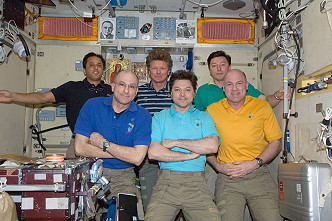 |
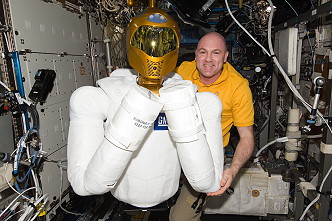 |
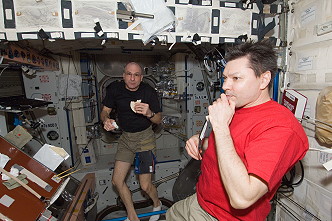 |
 |
 |
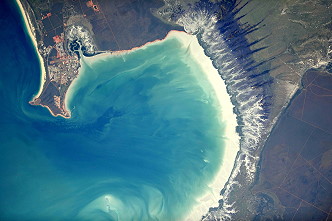 |
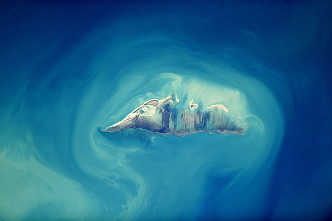 |
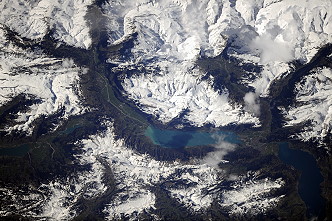 |
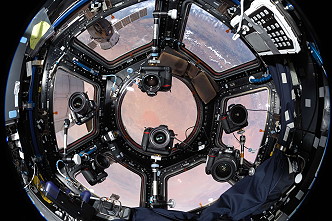 |
 |
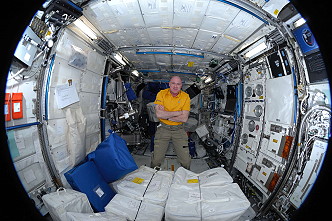 |
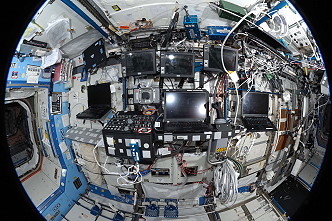 |
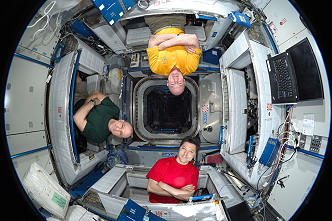 |
 |
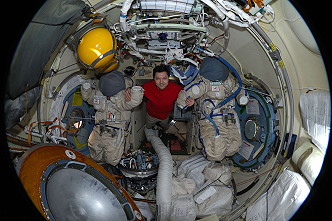 |
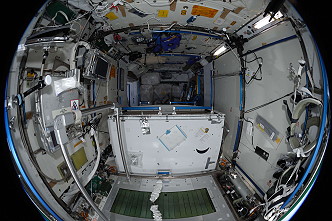 |
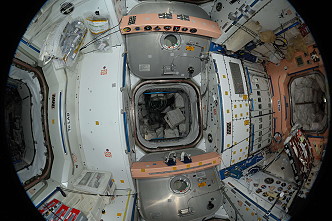 |
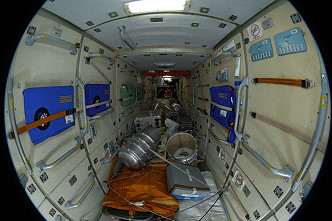 |
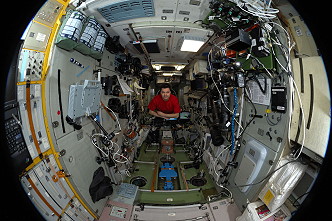 |
|
more Earth observation photos |
|
more onboard photos |
|
| © |  |
Last update on December 14, 2020.  |
 |
